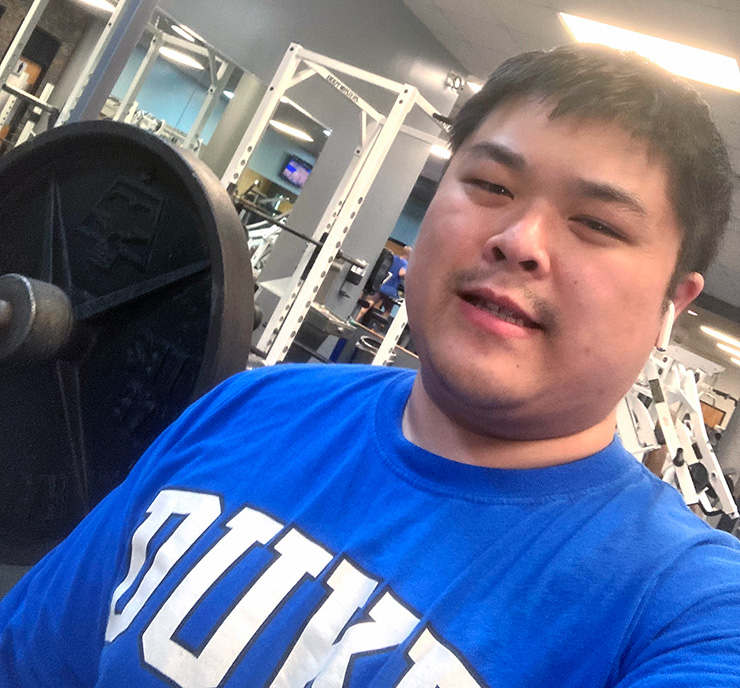Beyond Pay: Unique Duke Employee Benefits for Unique Needs
With Personal Benefits Statements sent to staff and faculty in May, five colleagues share how their benefits have helped them as part of their total compensation


In the past year, Duke paid about $3.6 billion in direct pay and spent $901 million on total benefits for its workforce. It contributed $249 million to retirement plans and spent $447 million on health care expenses for roughly 74,000 people covered by Duke’s plans, and each of those lives is unique.
In May, benefits-eligible Duke University and Duke University Health System staff and faculty will receive a personal benefits statement that provides an individualized view of their total compensation. With employee-specific information on the amount Duke contributes to their health insurance plan, life insurance and disability coverage, and retirement plans, the statement showcases how Duke’s investments go beyond gross pay.
“For us to remain an employer of choice, we have to make sure we meet the needs of our employees of all walks and all stages of life,” said Antwan Lofton, Vice President for Duke Human Resources and Chief Human Resources Officer. “Whether they are fresh out of college starting their career, or they are at a supervisor or director level or a tenured faculty, we have to have benefits that fit their lives.”
While the numbers that go into Duke’s benefits are large, each life touched by has its own individual story. We caught up with some Duke colleagues to hear how Duke’s benefits fit their unique needs.

A Bachelor’s Degree at Age 44
When Sabrina Jeter-Chambers graduated from high school, attending college was a goal, just not an attainable one at the time.
“I had a lot going on,” said Jeter-Chambers, now 51. “Life just happened.”
But life gave Jeter-Chambers, a Patient Account Associate in Duke Health’s Provider Enrollment Department, another chance, and in 2017, she earned a bachelor’s degree in Healthcare Administration from Pfeiffer University with the help of Duke’s Employee Tuition Assistance Program. The benefit provides eligible employees with up to $5,250 per calendar year to pay for eligible classes from accredited institutions.
The online courses that Jeter-Chambers completed were challenging, but she said knowing that Duke, where she’s worked for 25 years, was investing in her journey gave her motivation. And now, with a deeper understanding of how healthcare systems work and what patients and providers face, Jeter-Chambers said she’s able to provide better service to the Duke Health colleagues who lean on her.
“I had a lot of fear about going to a four-year college,” Jeter-Chambers sad. “What if I fail? What if I don’t do well? That was always in the back of my mind. But as I got older, being at Duke as long as I have been, it was something I kept thinking about. And with the tuition assistance program, I just figured, why not? I can do this.”

A Place for New Parents
In January 2020, Emilie Dye returned from maternity leave and was immediately on the move.
At the time, Dye had an office in Few Quad and supervised a team that included staff and students working in the Bryan Center, meaning her days were filled with trips between the two buildings. As she was bolting around campus, she also had to find time to pump breastmilk roughly three times each day for her daughter, Joslyn.
That’s when she gained a special appreciation for the lactation pod in the Bryan Center. Installed in 2019, the pod is one of several spaces on campus set aside for breastfeeding mothers and part of the reason Duke has been singled out as a good place to work for women and parents.
With her three daily pumping sessions blocked off on her Outlook calendar, Dye would make regular visits to the quiet, private space with comfortable seating and adjustable lighting.
“It was nice because it was a quiet space,” said Dye, now Director of Strategic Student Engagement for Student Affairs. “It was a great place to decompress. It felt very Zen. You could do what you needed to do, eat a snack and just breathe. You felt like everything was going to be fine.”

Supporting Healthy Routines
Two years ago, when Jonathan Chen spoke with a manager at Fuel Fitness gym about becoming a member, he was asked where he works. When he said Duke, the gym manager told him to check out the Duke Fitness Club, which is operated by LIVE FOR LIFE, Duke’s employee wellness program.
The club manages memberships to eligible area gyms for Duke faculty and staff, often at reduced rates and without long-term commitments. And the monthly gym memberships are paid through payroll deduction.
Through the Duke Fitness Club, Chen, a Pathologists’ Assistant in Duke University Hospital’s Surgical Pathology Lab, was able to get a discounted membership to Fuel Fitness for being a Duke employee.
Four days a week, Chen visits Fuel Fitness after work and does a weight training circuit he crafted with a personal trainer during one of the complimentary personal training sessions available to each gym member. He works his shoulders on Monday, biceps and back on Tuesday, chest and triceps on Wednesdays and he never skips working his legs on Thursdays.
“It’s such a stress-reliever,” Chen said. “Working in a fast-paced, high-volume laboratory like Surgical Pathology can be very stressful. So it’s nice to head to the gym after work, put on your headphones and just work out to decompress from the day.”

Catching Up on Savings
For much of her adult life, Lillian Rodermond, 43, was a stay-at-home mother to her two children. A few years ago, after several life changes, she rejoined the workforce, seeking financial security for herself.
While she found a few jobs she enjoyed, she wasn’t able to save much for retirement. It wasn’t until roughly two years ago, when she joined the staff of the Department of Cultural Anthropology, that she felt she was building a secure future.
“Once I got to Duke, I felt like I was able to begin making up for lost time,” said Rodermond, who moved into the role of the Business Manager for the Department of Romance Studies last year.
Rodermond now puts 15% of her paycheck into her 403(b) account with the Duke Faculty and Staff Retirement Plan. As part of the plan, Duke also contributes a certain amount each month.
“Everything is more expensive now, so you can always look at your paycheck and wish it was higher,” Rodermond said. “But when you see the stuff that’s not part of your paycheck, and you know that it’s going toward your retirement savings, which are creeping up higher and higher, you realize you’re earning more than you think.”
Send story ideas, shout-outs and photographs through our story idea form or write working@duke.edu.
Follow Working@Duke on X (Twitter), Facebook, and Instagram.